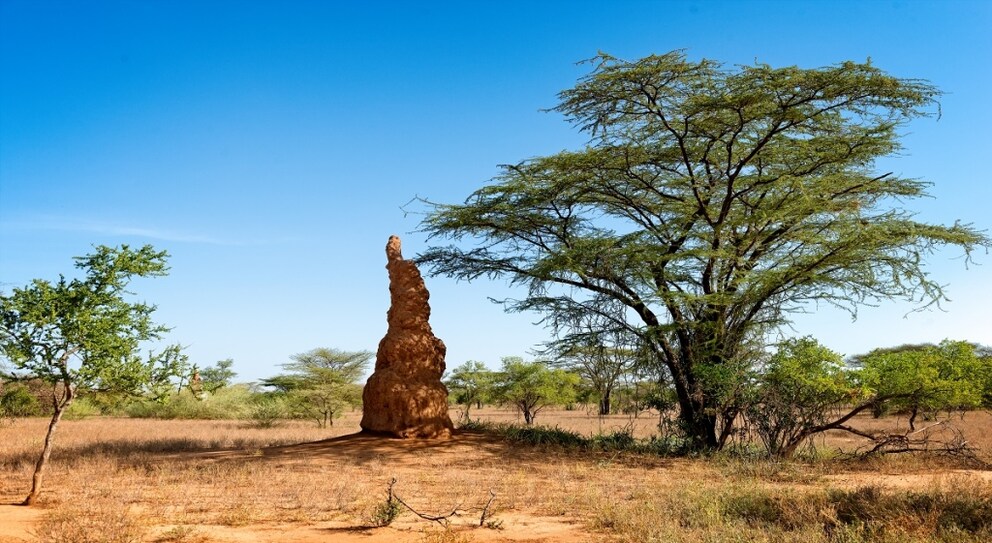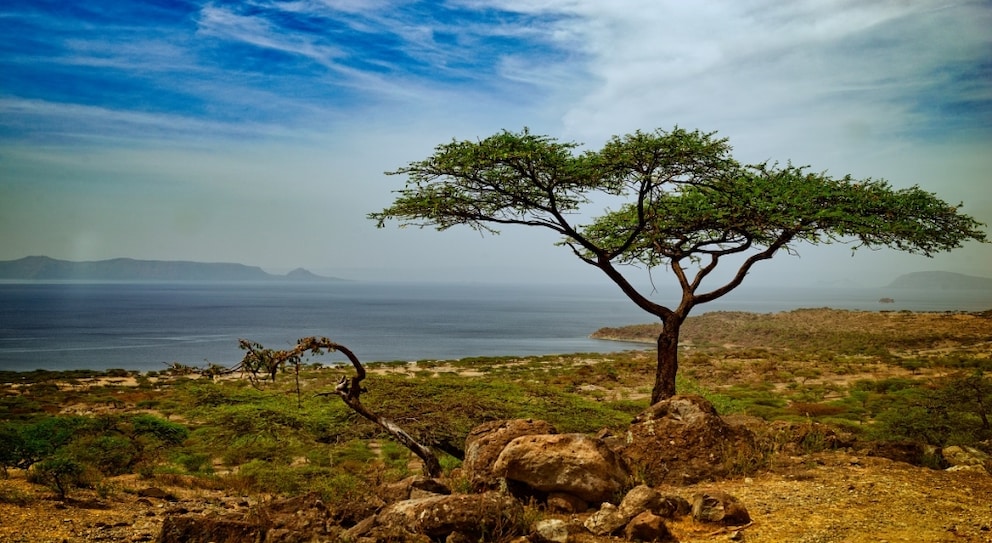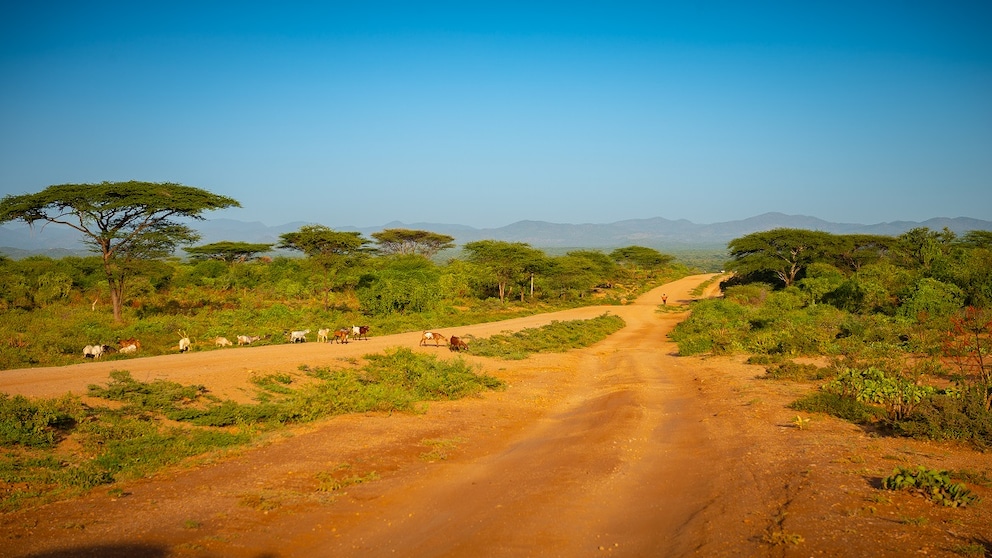January 13, 2025, 6:16 am | Read time: 7 minutes
In 2024, our author was lucky enough to travel to Ethiopia twice. He was particularly enchanted by the south of the country: Barren solitude spanning entire horizons, unique nature, and, in the midst of it all, fascinating people, some of whom still live here like their forefathers. However, he also saw a region whose magic is threatened with disappearance by tourism more than almost any other place.
Our car has been swaying and bumping along an unpaved sandy track for what feels like an eternity, a path that only in this place might qualify as a road, surrounded by vast emptiness. Nothing, which in this case means not even the tiniest sign that people live here. Or that humans as such even exist. Otherwise, the archaic, flat landscape explodes with life. Umbrella acacias and thorny scrubland as far as the eye can see. Termite mounds as large as obscure factory chimneys, the mighty mountain ranges on the far horizon that border the African Rift Valley like a dividing wall erected by God himself. And in the middle of it all, a few people. My travel group and I are here in what feels like the most unlikely place in the world, in the south of Ethiopia.
Overview
While the northeast African country remains one of the last great mysteries on the maps of even the most seasoned travelers, its southern reaches are truly uncharted territory—absolute terra incognita. Even today, in a world where everything seems to have been discovered, it is still a huge blank spot.
Places Like Movie Sets

For travelers accustomed to enduring long car journeys, the vast distances of southern Ethiopia are still beyond imagination. The entire country is as big as Spain and France put together. After Nigeria, it is the most populous country in Africa with 120 million inhabitants. A number, by the way, that seems completely unimaginable in the south. It is so rare to encounter people or even signs of civilization along the way. Places like Weito, Key Afer, Dimeka, Turmi, or Omorate would probably not be considered towns anywhere else in the world. The rest are a few scattered huts that sometimes look like the set for a movie about how Europeans imagine the “real” Africa. And truly, nothing can fully prepare you for the profound experience of meeting the people who call this place home.
And they are de facto also one of the main reasons for European agencies to offer trips to the south of Ethiopia. The many different ethnic groups that have inhabited this inhospitable region for thousands of years are probably one of the greatest anachronisms of our modern, hyper-technologized world. The conditions in which these proud people live—without electricity, running water, or other privileges we take for granted—may seem so simple to our understanding that when we meet them, we don’t even realize what we are encountering. Although your head and heart are aware that you are actually experiencing these situations, they sometimes seem like a wonderful, brightly colored daydream.
Also interesting: What you should know before traveling to Ethiopia
First the Smile, Then the Camera

And although a visit to the south of Ethiopia may seem as if you have stumbled through a magical portal from the modern age directly into the Neolithic period, it is by no means backward or poor. Rather, it is simply astonishing, stunning, and completely overwhelming in the best of all senses. It is nothing but admiration for people who seem so happy and content in such simplicity.
And for the visitors from a foreign world, they often have so much more than they could actually give. I accept individual fragments of language from the respective ethnic groups like precious treasures, and that’s exactly what they are. “Hello,” “How are you?”, or simply “Thank you.” These actually tiny insights into a culture are like keys, door openers for the hearts of the locals. The moment when you utter a phrase like this for the first time, unconfidently and probably with the wrong accent, and make an entire village smile is something you will never forget.
Just as little as the unconditional friendliness of the people in the south of Ethiopia. The almost childlike curiosity of even adults, thanks to which the boundaries between the locals and us visitors often become completely blurred. This is a unique opportunity for cultural exchange. As a guest, the first thing local people should see of you is a smile. And by no means a camera with which you storm in on a movie star like paparazzi. When a whole crowd of children surrounds you, laughing with big eyes and countless little hands clinging to individual fingers, your heart does somersaults. Your heart flutters wildly, struggling to contain the overwhelming joy and emotion.
A Disappearing World
Away from the encounters, it is the loneliness and the endless expanse of the landscape that touch the soul in a strange way. So much space for people as small as us is something that city dwellers like me are simply not used to. Your thoughts suddenly take a completely different direction. They can really be free to fly in all directions. Of course, the peace and quiet, the complete absence of hustle and bustle and noise also contributes to this. The night’s starry sky performs a unique cosmic ballet, giving the impression that one could gaze directly into the countless galaxies. All the way back to the beginning of time itself, which seems to play no role at all here in the south of Ethiopia. Only the calls of exotic birds, monkeys, or hyenas cut through the silence. Otherwise, inner peace as on the first day of creation.
It dawns on you gradually that even as a mere visitor in this timeless landscape, your presence leaves a deeper imprint than you might first imagine. Because nothing changes the south of Ethiopia as quickly as the influences of modernity and the outside world. In particular, social media and tourism. The former is giving many people an insight for the first time into the fact that other realities of life are possible, than those that have been lived according to tradition for generations. The latter, tourism and visitors’ money, suddenly bring these alternative realities, which for many seem tempting, within reach. If the internet shows a Western-style image of supposed modernity, who could blame young people in particular for wanting to be part of it?

TRAVELBOOK author on site What you should definitely know before traveling to Ethiopia

Spiritual Capital of the Island Why Ubud Was the Berlin of Bali for Me

TRAVELBOOK Author on Site Is a Visit to Bali’s Trendy Resort of Canggu Worthwhile?
A Wish for the Future
An ethnologist I spoke to about this dilemma on my first visit said something shocking to me. She estimated that it would only be a few years before the traditional life of the people in the south of Ethiopia disappeared completely under the influence of the factors mentioned above. I can’t imagine that I, as a tourist, am obviously partly to blame for this. And yet, or perhaps precisely because of this, I will travel to Ethiopia again, because as a journalist you are always a chronicler at best. This world, which is obviously undergoing such radical change, simply must not be lost forever. And it certainly won’t be lost if we allow it to endure, at least in the sanctuary of our hearts.
Of course, I would wish even more that it never has to come to that. That future generations of travelers can still experience the exhilarating feeling of strolling through one of the colorful markets in the south of Ethiopia among the locals. To share in the same wonder I felt driving past a vast herd of cattle, kicking up a miles-long trail of dust. When children wave happily from a waterhole as you drive past, or when they run screaming after your car. May the people here inhabit and cultivate the same cracked red earth forever, as they have done since time immemorial.

